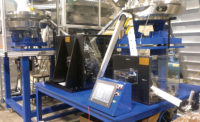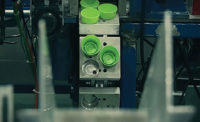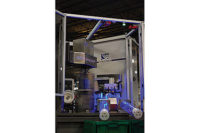High-speed automation for bottle cap assembly
Continuous motion assembly system produces three-piece caps for plastic squeeze bottles.






Plastic squeeze bottles for water or Gatorade are ubiquitous at sporting events around the world. Hundreds of millions of them are produced annually.
Millions of bottles need millions of push-pull caps. To produce that kind of volume, there’s really only one option: a continuous motion assembly system. Such systems can routinely produce 400 to 800 parts per minute, and some machines can produce more than 1,800 parts per minute. In contrast, rotary indexing dials or pallet-transfer systems can produce 15 to 250 assemblies per minute.
With intermittent motion systems, assemblies must pause periodically so that some action can be performed. The assembly tools, such as pick-and-place units, are stationary. With continuous motion systems, the assemblies never stop moving. Operations are carried out as the parts are moving, and the tools travel with the work in process.
Such a system was exactly what a nationally known manufacturer of plastic closures needed to efficiently feed, orient, and assemble a three-piece push-pull cap for a plastic squeeze bottle. Shibuya Hoppmann Corp. designed and built the system, which assembles the caps at speeds of more than 500 parts per minute. This system also inspects each cap before it proceeds downstream for further processing.
It consists of four major elements: a feed system for the base cap, a feed system for the push-pull spout, a feed system for the over cap, and a pair of rotating assembly turrets.
The base caps, spouts and over caps exit prefeeders into centrifugal feeders. These feeders do not use vibration to singulate and orient parts. Instead, they rely on the principle of centrifugal force. Parts drop onto a rotating disc, and centrifugal force whisks them to the periphery of the circle, where they encounter tooling to orient them correctly.
The base caps, spouts and over caps are oriented diameter to diameter. They then exit the feeders into an accumulation conveyor for delivery to the assembly turrets.
These rotating turrets are the heart of a continuous motion assembly system. Each turret consists of a round dial with a series of tools, called pins, arrayed around its circumference. The size of the turret and the number of pins varies, depending on the size of the parts, the number of assembly operations, and the production volume.
Parts enter the system single file on tracks from feeders or upstream operations. A star wheel, moving synchronously with the turret, strips off parts one after another and transfers them into nests spaced evenly around the dial. As the turret rotates, each pin is actuated in turn until the process is complete and the assembly is unloaded. The pins are most often actuated by cams, but they can also be controlled by servomotors.
Parts assembled on continuous motion systems are typically round and symmetrical, but they don’t have to be. The systems work best with parts that can be snapped or pushed together quickly and easily. However, these systems can accommodate most assembly processes, as long as they can be done quickly and from a vertical direction.
In the Shibuya Hoppmann system, the base caps and spouts enter the first turret via pocketed transfer wheels. The base cap is placed in the lower nest, while the spout is picked up by a vacuum head and held in place by a hanger yoke. For better molding and handling, the spout is molded with a thin floor at the bottom.
Once the base cap and spout are in position, the floor at the bottom of the spout is punched out. The pickup head then snaps the spout into place on the neck of the base cap.
The base cap assembly is passed to the second turret. It is placed in the lower nest, while the over cap enters the turret on the upper level. Like the spout, the over cap is molded with a thin floor at the bottom. A vacuum head drops down, picking up the over cap as the floor beneath it is punched out. When the over cap is positioned above the base cap assembly, the pin is cammed downward, snapping the over cap into place and completing the assembly.
For more information on continuous motion assembly systems, call 800-368-3582 or visit www.shibuyahoppmann.com.
Editor’s note: Whether you’re a systems integrator or the in-house automation team of an OEM, if you’ve designed a system that you’re particularly proud of, tell us about it. Send an e-mail to John Sprovieri, editor of ASSEMBLY, at sprovierij@bnpmedia.com, or call 630-694-4012.
Looking for a reprint of this article?
From high-res PDFs to custom plaques, order your copy today!









